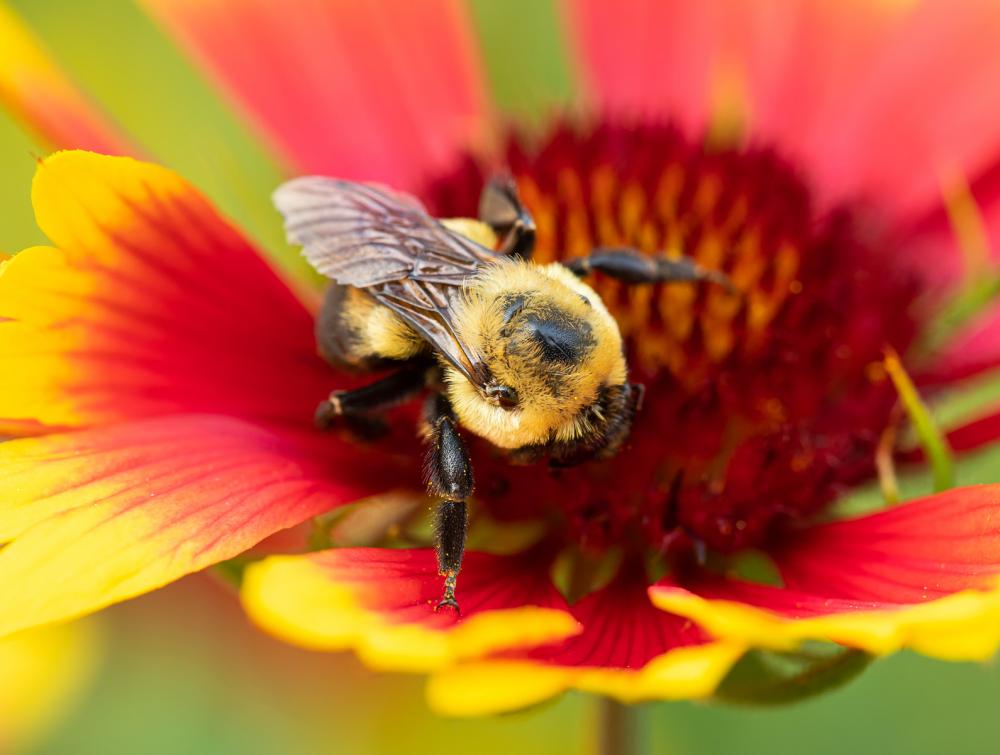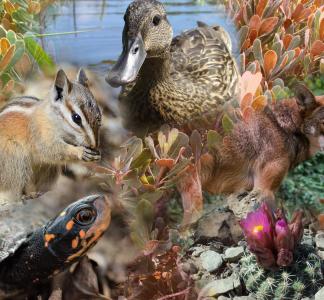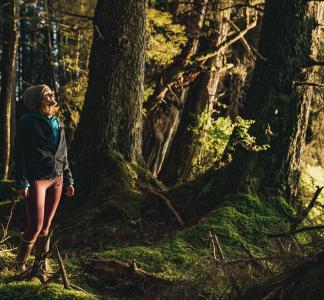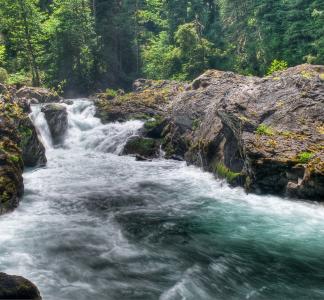6 ways extinction and nature loss hurt people

Bumblebee in a U.S. Department of Agriculture "wildflower pollinator meadow"
Kirsten Strough, USDA, Flickr
Crisis affects health, food, climate change readiness
If you’re reading this, there’s a solid chance you already know: the mounting mass extinction crisis and loss of wild nature are really, really bad news.
But that’s not obvious to everyone. After all, what does the dwindling population of some tiny insect, or a few more acres of forest being logged a thousand miles away, have to do with me? People have families to feed, bills to pay, and more than enough tsuris to worry about in day-to-day life as it is, never mind the latest scientific research on dwindling biodiversity.
Sadly, the extinction crisis and nature loss do affect people. And though the consequences land with disproportionate impact on some—especially communities of color and low-income people—it will leave nobody truly unaffected.
In the vivid words of one 2021 report, “humanity is running an ecological Ponzi scheme in which society robs nature and future generations to pay for boosting incomes in the short term.” That sounds about right: drill, mine, log and pollute today, stick someone else with the bill later on.
Unfortunately, “later on” is now. Extinction and nature loss are already threatening to...
1. ...make people sicker
In truth, every problem on this list negatively affects our health, and there’s quite a bit of overlap between them. But here we’re talking about the ways that the extinction crisis and nature loss directly make us sick (or sicker).
For one thing, recent research suggests that nature loss increases the likelihood of pandemics like COVID-19. As human development pushes deeper into formerly “wild” areas, people are exposed to more new disease vectors (a major share of emerging infectious diseases are the kind that jump from animals to people). Additionally, as species move around to adapt to climate shifts, they may bump up against communities that otherwise wouldn’t have encountered them, causing “spillover” of dangerous pathogens from wildlife.
Nature loss can also weaken the biodiversity that collectively dilutes and defends against some disease threats. For instance, scientists say that more diverse bird populations can help buffer humans against the effects of West Nile virus.
Deterioration of nature hurts our ability to heal, too. Numerous important medicines, including treatments for heart disease, Parkinson’s disease and various cancers, are derived from natural sources like plants and fungi. Biodiversity loss is threatening those resources, plus countless medicines yet to be discovered.
2. ...decrease water and air quality
When they’re trying to quantify how important wild nature is, scientists sometimes bundle clean air, water, and other communal benefits into a category called “ecosystem services.” Unsurprisingly, the forces that are decimating wildlife and ecosystems—pollution, runaway development, etc.—are doing a number on these building blocks of survival, too.
Basic example: Forests create a water treatment network that catches rainfall, regulates storm runoff, and pulls pollutants from the soil rather than allowing them to make it back to streams and rivers. Tens of millions of people rely on forests as an intermediary to filter their drinking water. When those forests are depleted—by being logged or cleared for factory-farming, say—it severely weakens that safety net.
Trees also filter out air pollution and help people breathe easier (you’ve probably heard that before). The same logic as above holds true here; loss of forests means more and worse pollution. In the Amazon, perhaps the world’s most-studied forest environment, research has demonstrated that reduced deforestation benefits air quality and public health.
3. ...hurt our ability to grow and gather food
One of the best chronicled examples of nature loss in recent years has been the decline of pollinators like bees, bats, and butterflies. Plants that depend on pollination account for 35 percent of global crop production volume, and the continued decline of those species—chiefly caused by habitat destruction—poses a serious threat to global human well-being.
But there’s another threat to food production that hasn’t been discussed nearly as much: degradation of the quality of soil, which has affected one-third of the Earth’s surface. Among other things, soil degradation is caused by deforestation, exploitative industrial-scale agriculture, pollution, and climate change. Data suggest that over 35 percent of land suitable for crops has been degraded by human activities since 1950. Experts say that allowing all that soil to become barren or nutrient-deficient is among the factors “posing serious challenges to humanity for future food security.”
4. ...deepen the impact of extreme weather events
As you probably know, climate change is super-charging extreme weather events, resulting in more severe heat waves, bigger wildfires, and stronger hurricanes. What you may not know is that human destruction of wild nature by development and other means can help make those disasters hit even harder and wreak more destruction.
For a big example, let’s look at forests (notice how many of these examples are about forests? They’re really important). Studies of the Amazon have shown that deforestation increases fire risk by removing natural vegetation cover and creating drier conditions. Wildfires are part of the ordinary life-cycle of any forest, but just as climate change is creating ideal conditions for these to rage out of control, large-scale logging—in contrast to targeted ‘thinning’ of some trees as a management tactic—disrupts the natural order of these fires and ends up creating bigger disasters when they do happen.
Loss of forests is associated with worse flooding disasters, too (tree roots help absorb water and keep soil locked in place; when those trees depart, it can help spur erosion and cause sediment-choked, overflowing waterways). Along coastlines, landscapes like salt marshes and mangrove forests are an important buffer against major storms, working like a natural sponge to dull the impact of ocean swells. But these coastal wetlands are threatened by development and human-engineered drainage, among other factors, weakening another front-line defense against climate catastrophes.
5. ...weaken our ability to combat climate change
In addition to making some climate disasters hit harder, humankind’s destruction of the natural world is reducing our ability to fight the underlying causes of the climate crisis.
Once again, look to the trees. When forests are logged or otherwise disrupted, it turns crucially important climate pollution-trapping “carbon sinks” into carbon emitters. Similarly, soil that has been changed by human activities like mega-scale farming releases a huge amount of greenhouse gases into the atmosphere.
We know that public lands like national parks and wilderness areas serve an important role in confronting the climate crisis. We can’t let runaway development and other threats totally undercut those natural allies.
6. ...make us miserable (probably)
There is a broad consensus that nature positively influences our physical and mental health. So what effect do you think it has when a host of human-caused hazards wipe out wilderness and drive species to extinction?
It’s hard to say definitively, but it stands to reason that destruction of nature does and will continue to hurt the mental health of those who have relied on nature for emotional succor. Experts have already begun studying "ecological grief,” which arises from "either physical ecological losses, loss of environmental identity, or anticipated future ecological loss.” Researchers speculate that this condition may operate in a similar way to bereavement after the death of a loved one, and it could increase risk of some mental disorders. In particular, Indigenous people, farmers or others who live close to and work on the land are thought to be more vulnerable to ecological grief.
In recent years, some doctors have been prescribing time in nature as one of the ways people can boost their mental and physical health (a new Canadian program even empowers doctors to hand out free park passes). Indeed, increasing access to nature and green spaces should be a priority. While we’re doing that, we must also oppose the runaway development and other forces that threaten those same precious resources.
What can we do about it?
As climate change and other threats put more pressure on wild nature—and therefore on people—in the U.S. and worldwide, it is vitally important we secure a network of land and water that lets species adapt free of undue interference. The logical starting point for that project is the national parks, wilderness areas and other public lands we’ve already protected—hubs of a life-support system that will stand as a bulwark against extinction here and abroad.
Learn more about why we need to protect at least 30 percent of lands and waters by the year 2030.



